It has been almost ten years since the concept of a ticket disappeared and was replaced by the simplified invoiceHowever, it may be out of habit, nostalgia, or simply because the term is shorter, we continue to speak colloquially of ticket when we ask for proof of purchase of an asset of low value.
And it is precisely this low value of common purchases that justifies the need to have a medium agile and simple to collect the purchase details and justify, thus, the transition made.
But, although it may seem like it, a Commercial transaction It is never a matter of two, since the odd tax is derived from it, which means that, where there were two parties that negotiated the conditions of the operation, another interested party is added who will impose its conditions, Treasury.
What are simplified invoices and how do they arise?
The ordinary invoice It is a document issued by a businessman or professional that includes the details of a commercial operation carried out. It is Royal Decree 1619/2012, of November 30, better known as the Billing Regulations, which regulates billing obligations and the requirements that must be met.
As for the invoice contentIn all of them, it must include:
- Number and serial if apply.
- Expedition date.
- Identification of the issuer of the invoice: name or denomination, NIF and address.
- Identification of the recipient of the invoice: name or denomination, NIF and address.
- Description of the operations carried out.
- Tax base, VAT rate applied and tax rate.
If we look closely, the businessman or professional who issues the invoice has all the required information, all, except the identifying data of the client, which forces him to ask for them.
Imagine then the chaos that would result if for every small daily purchase made, the seller had to take note of the identifying data of each of his clients.
And, precisely to avoid this chaos, the concept of simplified invoice Therefore, in the event of any operation with a total amount of less than 400 euros or specific operations determined in the Regulation that do not exceed 3,000 euros, The issuer of the invoice is authorized not to include the recipient's identification data, as well as to reflect only the total amount of the invoice along with the expression "VAT included." Otherwise, it is identical to the ordinary invoice.
Tax control
One of the functions performed by invoices, in addition to representing the terms in which a commercial operation has been carried out, is to facilitate the AEAT's control of the correct application of taxes, since in this document All the data that the Public Treasury needs to determine the tax that must be applied is reflected., identify the taxable person and verify the amount of taxes involved in said operation.
And, when the commercial operation is carried out between two businessmen or professionals, normally, one of them charges VAT and accrues Corporate Tax or Personal Income Tax through the profit generated by the operation, and the other can deduct taxes for the expense incurred and the input VAT amounts.
The regulations for each tax then enter here to establish the conditions required to be able to deduct that tax by the recipient of the invoice and these conditions must combine two rights that, on many occasions, are conflicting, that of the taxpayers to benefit from the deduction and that of the Treasury to exercise effective control over the application of taxes.
Well, one of these occasions arises with the simplified invoices, since they do not include the VAT amount to be deducted, nor is the recipient of the document identified, who is, in the end, the one who will benefit from the deductions.
Invoice requirements to be able to deduct them
The regulations of Corporate Tax and Personal Income Tax There is no specific reference to the formal requirements for expenses to be deductible in the tax, therefore, we must refer to the General Tax Law, which in its article 106.4 provides that deductible expenses must be justified, as a priority, by invoice.
However, it does not specify the invoice typeTherefore, it is understood that the simplified invoice is valid to deduct the expense in these taxes, however, it must be able to prove that the person deducting it was the one who actually incurred the expense. This could be done, for example, by bank receipt of payment.
However, in the VAT is different, the Law that regulates your tax does make express reference to the formal requirements necessary to be able to practice the deduction and, in its art. 97, considers the original invoice as the only supporting document. It also does not specify the type of invoice, however, it points out that it will be essential that it includes “each and every one of the requirements established by law and regulations.”

Can a businessman or professional then deduct VAT from a simplified invoice?? The answer is yes, as long as the document contains, in addition to the data required for the simplified invoice, the identification data of the recipient of the invoice and the itemized VAT quota, as provided in art. 7.2 of the Billing Regulations.
In this way, what has come to be called qualified invoice which is nothing more than a simplified invoice to which the recipient's data has been included and the VAT amount has been broken down.
What can I do if I have a simplified invoice?
If I want to deduct the amount as activity expense, I will be able to do so, as long as I have any other form of proof admissible by law that proves that it was my company that has really incurred that expense.
If I want, furthermore, deduct VAT, on the simplified invoice I must ensure that the VAT amount is broken down and that our identification data is included.
What if this information is not available? I then propose these two solutions:
- Go to the issuer of the simplified invoice and request that the replace with an ordinary invoice. This ordinary invoice can even be recapitulative and include several simplified invoices that have been issued within the same calendar month.
- Simply, ask the issuer of the simplified invoice to include our name, address and NIF, as well as the breakdown of the tax quota. It is important to remember that this must be done by the issuer of the invoice, as he is the only one authorized to modify it.
Although, the most appropriate thing to avoid this rectification is have the complete invoice from its issuance, for this, experienced businessmen or self-employed people usually have their data ready to deliver when making these small purchases and request the invoice to be sent by email or WhatsApp, so they do not have to wait.
To be able to put all this knowledge about invoices and taxes into practice in a company, you can train with the Master in Financial Management, Accounting and Management Control, which will enable you to be the financial director and carry out comprehensive management within companies using the appropriate technology for this.




































